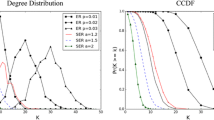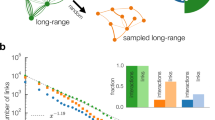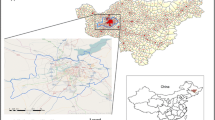Abstract
This article addresses the role of spatial interaction in social networks. We analyse empirical data describing a network of leisure contacts and show that the probability to accept a person as a contact scales in distance with ∼ d − 1.4. Moreover, the analysis reveals that the number of contacts an individual possesses is independent from its spatial location and the spatial distribution of opportunities. This means that individuals living in areas with a low accessibility to other persons (rural areas) exhibit at average the same number of contacts compared to individuals living in areas with high accessibility (urban areas). Low accessibility is thus compensated with a higher background probability to accept other candidates as social contacts. In addition, we propose a model for large-scale social networks involving a spatial and social interaction between individuals. Simulation studies are conducted using a synthetic population based on census data as input. The results show that the model is capable of reproducing the spatial structure, but, however, fails to reproduce other topological characteristics. Both, the analysis of empirical data and the simulation results provide a further evidence that spatial interaction is a crucial aspect of social networks. Yet, it appears that spatial proximity does only explain the spatial structure of a network but has no significant impact on its topology.









Similar content being viewed by others
Notes
Edges obtained from the sociogram are only used for the analysis of transitivity but ignored for all other analyses.
References
Amaral LAN, Scala A, Barthélémy M, Stanley HE (2000) Classes of small-world networks. Proc Natl Acad Sci USA 97(21):11149–11152
Andrade JS, Herrmann HJ, Andrade RFS, da Silva LR (2005) Apollonian networks: simultaneously scale-free, small world, euclidean, space filling, and with matching graphs. Phys Rev Lett 94(018702):1–4
Backstrom L, Sun E, Marlow C (2010) Find me if you can: improving geographical prediction with social and spatial proximity. In: Proceedings of WWW 2010, pp. 61–70
Barabási AL, Albert R (1999) Emergence of scaling in random networks. Science 286:509–512
Barrat A, Barthélemy M, Vespignani A (2005) The effects of spatial constraints on the evolution of weighted complex networks. J Stat Mech: Theor Exp 5:1–20
Barthélemy M, Flammini A (2009) Co-evolution of density and topology in a simple model of city formation. Netw Spat Econ 9:401–425
Ben-Akiva M, Lerman SR (1985) Discrete choice analysis. The MIT Press, Cambridge, MA
ben-Avraham D, Rozenfeld AF, Cohen R, Havlin S (2003) Geographical embedding of scale-free networks. Physica A 330:107–116
Boguñá M, Pastor-Satorras R, Díaz-Guilera A, Arenas A (2004) Models of social networks based on social distance attachment. Phys Rev E 70(056122):1–8
Butts CT (2002) Predictability of large-scale spatially embedded networks. Tech. rep., Institute for Mathematical Behavioral Sciences, UC Irvine
Butts C, Carley K (2001) Spatial models of large-scale interpersonal networks. Tech. rep., Center for Computational Analysis of Social and Organizational Systems (CASOS)
Carrasco JA (2006) Social activity-travel behaviour: a personal network approach. Ph.D. thesis, University of Toronto
Daraganova G, Pattisona P, Koskinen J, Mitchell B, Bill A, Watts M, Baum S (2012) Networks and geography: modelling community network structures as the outcome of both spatial and network processes. Soc Netw 34(1):6–17
Erath A, Löchl M, Axhausen K (2009) Graph-theoretical analysis of the swiss road and railway networks over time. Netw Spat Econ 9:379–400. doi:10.1007/s11067-008-9074-7
Federal Office for Spatial Development and Swiss Federal Statistical Office (2007) Mobilität in der Schweiz, Ergebnisse des Mikrozensus 2005 zum Verkehrsverhalten. Neuchâtel, Bern
Festinger L, Schachter S, Back K (1963) Social pressures in informal groups. Stanford University Press, Stanford, California
Frei A, Axhausen KW (2007) Size and structure of social network geographies. Working Paper 439, ETH Zürich, Institute for Transport Planning and Systems
Gastner MT, Newman MEJ (2006) The spatial structure of networks. Eur Phys J B 49(2):247–252
Goldenberg J, Levy M (2009) Distance is not dead: social interaction and geographical distance in the internet era. arXiv:0906.3202v2
Hayashi Y (2006) A review of recent studies of geographical scale-free networks. IPSJ Digital Courier 2:155–164
Hoff PD, Raftery AE, Handcock MS (2002) Latent space approaches to social network analysis. J Am Stat Assoc 97(460):1090–1098
Hu Y, Wang Y, Li D, Havlin S, Di Z (2011) Possible origin of efficient navigation in small worlds. Phys Rev Lett 106(108701):1–4
Illenberger J, Flötteröd G (2011) Estimating properties from snowball sampled networks. Working Paper 11-01, TU Berlin, Transport Systems Planning and Transport Telematics
Kowald M, Frei A, Hackney J, Illenberger J, Axhausen KW (2009) Using an ascending sampling strategy to survey connected egocentric networks: a field work report on phase one of the survey. Working Paper 582, ETH Zürich, Institute for Transport Planning and Systems
Lambiotte R, Bondel VD, de Kerchove C, Huens E, Prieur C, Smoreda Z, Dooren OV (2008) Geographical dispersal of mobile communication networks. Physica A 387:5317–5325
Larsen J, Urry J, Axhausen KW (2006) Mobilities, networks, geographies. Ashgate, Aldershot
Larsen J, Urry J, Axhausen KW (2008) Coordinating face-to-face meetings in mobile network societies. Inf Commun Soc 11(5):640–658
Latané B, Liu JH, Nowak A, Bonevento M, Zheng L (1995) Distance matters: physical space and social impact. Pers Soc Psychol Bull 21(8):795–805
Liben-Nowell D, Novak J, Kumar R, Raghavan P, Tomkins A (2005) Geographical routing in social networks. Proc Natl Acad Sci USA 102(33):11623–11628
Manna SS, Sen P (2002) Modulated scale-free network in euclidean space. Phys Rev E 66(066114):1–4
Masuda N, Miwa H, Konno N (2005) Geographical threshold graphs with small-world and scale-free properties. Phys Rev E 71(036108):1–10
McPherson M, Smith-Lovin L, Cook JM (2001) Birds of a feather: homophily in social networks. Annu Rev Sociology 27:415–444
Mok D, Wellman B, Basu R (2007) Did distance matter before the internet? Interpersonal contact and support in the 1970s. Soc Netw 29:430–461
Mokhtarian PL (2002) Telecommunications and travel: the case for complementarity. J Ind Ecol 6(2):43–57
Newman MEJ (2001) Scientific collaboration networks. I. network construction and fundamental results. Phys Rev E 64:016131
Newman MEJ (2002) Assortative mixing in networks. Phys Rev Lett 89(20):1–4
Reggiani A, Bucci P, Russo G (2011) Accessibility and network structures in the german commuting. Netw Spat Econ 11:621–641
Schintler L, Kulkarni R, Gorman S, Stough R (2007) Using raster-based gis and graph theory to analyze complex networks. Netw Spat Econ 7:301–313. doi:10.1007/s11067-007-9029-4
Tilahun N, Levinson D (2011) Work and home location: possible role of social networks. Transp Res Part A 45:323–331
Watts DJ, Strogatz SH (1998) Collective dynamics of ‘small-world’ networks. Nature 393:440–442
Wilson A (1971) A family of spatial interaction models, and associated developments. Environ Plan 3:1–32
Wong LH, Pattison P, Robins G (2006) A spatial model for social networks. Physica A 360(1):99–120
Acknowledgement
This work was funded by the VolkswagenStiftung within the project “Travel impacts of social networks and networking tools”.
Author information
Authors and Affiliations
Corresponding author
Rights and permissions
About this article
Cite this article
Illenberger, J., Nagel, K. & Flötteröd, G. The Role of Spatial Interaction in Social Networks. Netw Spat Econ 13, 255–282 (2013). https://doi.org/10.1007/s11067-012-9180-4
Published:
Issue Date:
DOI: https://doi.org/10.1007/s11067-012-9180-4




